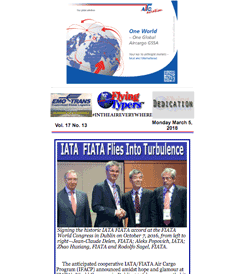
Normality
began to return to air freight markets as factories in China reopened
following the Asian Lunar New Year, popularly called Chinese New Year
(CNY) holidays.
TAC Into
The Wind
The TAC Index covering average prices per kilo
from Shanghai PVG to Europe fell 9 percent to CNY 17.40 (USD 2.76) on
February 5, but by March 5, and even after falling 12.2 percent week-on-week,
the average gateway price was CNY 15.91 per kg—not as low as some
had feared.
A similar trend was apparent on the Hong Kong-North
America lane where the average price on March 5 was $3.63 per kg, down
only marginally compared to the USD $3.68 per kg recorded by TAC Index
on February 5.
 No
Woe Wu No
Woe Wu
Brian Wu, Chairman of the Hong Kong Association
of Freight Forwarding, told FlyingTypers last week that the air
cargo market out of HKIA, the world’s biggest freight hub, had been
steady since manufacturers resumed output post CNY.
“The price of the air cargo market is still
on the low side,” he added. “Demand is still steady and stable.
We hope it will be picking up next week.”
Flex Ability
Flexport reported “some capacity restraints”
ex-China, adding that while rates were currently stable “we expect
them to increase in the second half of March.”
Ex-HKIA, the digital forwarder predicted demand
would remain high leading up to the Easter holidays, while, ex-U.S., it
reported that post-CNY freighters out of LAX were experiencing capacity
restraints and shippers were suffering delayed shipments.
“Chinese New Year was late this year, which
helped prevent rates from rising too much before the holiday,” it
added.
“The market was slow for a couple of weeks
after CNY as factories ramped back up to full production.
“Now that we’re in March, the market
is picking up steam—we’re seeing some capacity constraints,
and rates will begin increasing soon.
“Demand will remain high leading up to
the Easter holiday, with rates and capacity expected to stabilize come
April.”
Too Early
To Call
With year-on-year analysis difficult in the first
months of each year because of the vagaries of the lunar calendar, World
ACD said it was too early to tell if it had been a good start to the year
for air cargo. In January, the latest month for which volumes figures
were available as FlyingTypers went press, the analyst said worldwide
air cargo yield fell to USD 1.89, 7.8 percent below December, but 16.8
percent higher than January 2017.
“Taking the year-over-year (YoY) figures
for January 2018 at face value, 2018 would seem to be off to a very good
start,” it noted. “Virtually all airlines recorded a USD-revenue
growth, more than one third of all reporting airlines realized volume
increases from 10-50 percent, and worldwide volume was up by 8.5 percent.
“Yet, it is too early to qualify this year's
start.”
The analyst noted that volume trends were difficult
to interpret due to Chinese New Year (CNY)—a sizeable influencer
of overall trade—which fell on January 28 last year and on February
16 this year.
“CNY normally has two effects on trade:
a spike in trade before, and trade diminishing afterwards,” said
WorldACD.
“And although the negative influence is
usually felt during the two weeks following CNY, the first four days bear
the brunt of the decrease.
“Thus, with GDP-growth in the world continuing,
one would expect January to be much better in 2018 than in 2017. But by
how much? Based on FTK-data for the first three weeks of January, we believe
that YoY volume growth in this ‘pre-CNY-period’ may well have
been in the range of 4-6 percent. Serious growth, surely, but hinting
at an overall growth pace lower than the increase shown in the full January-figures.
Once February data is in, we will be able to judge how the start of 2018
has really been.”
IATA Warning
Trump Affect
 Alexandre de Juniac, IATA’s Director General and CEO, warned that
one potential headwind could be President’s Trump’s decision
to impose import tariffs on aluminum and steel. “There is a very
real risk of a trade war. Nobody wins when protectionist measures escalate,”
he added.
Alexandre de Juniac, IATA’s Director General and CEO, warned that
one potential headwind could be President’s Trump’s decision
to impose import tariffs on aluminum and steel. “There is a very
real risk of a trade war. Nobody wins when protectionist measures escalate,”
he added.
Despite the difficulties of judging trends based
on volume analysis, IATA was quick to declare that 2018 was off to a “robust
start,” noting that demand, measured in freight ton kilometers (FTKs),
rose 8.0 percent in January 2018 compared to the year-earlier period.
This was up from the 5.8 percent annual growth recorded in December 2017.
“The continued positive momentum in freight
growth into 2018 reflects the fact that demand drivers for air cargo remain
supportive,” said its monthly report. “Global demand for manufacturing
exports is buoyant and meeting this strong demand is leading to longer
supply chain delivery times. Demand for air cargo may strengthen as a
result, with companies seeking faster delivery times to make up for longer
production times.”
SkyKing
|





